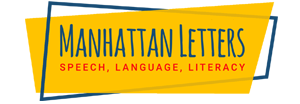The scope of speech language pathology is diverse and one of my goals for the Brooklyn Letters website is to educate others about my profession. When I meet new people and we discuss what I do professionally, I find it difficult to give a brief explanation about language pathology and its treatment.
Reading and writing What does that have to do with speech Is a common reaction from those inquiring about what I do. Unlike language pathology, speech pathology is more straightforward to explain to others, e.g. child has difficultly enunciating the “r” sound.
I recently read an article from a journal that I find very helpful for those interested in learning more about how language pathology connects with literacy and learning.
The following excerpt is from the article “Back to School: Why the Speech-Language Pathologist Belongs in the Classroom,” by Dr. Marilyn A. Nippold. Marilyn A. Nippold, Ph.D., holds an Endowed Professorship at the University of Oregon where she has worked since 1982, teaching and conducting research in later language development, literacy, language disorders, and stuttering.
Back to School: Why the Speech-Language Pathologist Belongs in the Classroom
Sam is a 12-year-old boy who recently began the sixth grade at a rural middle school. Like many of his classmates, Sam spent a relaxing summer playing baseball, fishing, and swimming at a nearby lake. However, now that the school year is underway, he is experiencing increasing frustration in the classroom. Unlike most of his classmates, Sam has a language disorder.
If a sixth-grade child such as Sam has deficits in syntax (grammar), the lexicon (vocabulary), word decoding, and reading comprehension, those deficits are likely to continue into adulthood if left untreated by qualified professionals (Nippold & Tomblin, 2010). Moreover, Sam’s frustration in the classroom is likely to increase as the language demands become even greater during middle school and high school, resulting in a diminishing sense of confidence, optimism, and enjoyment of academic pursuits.
On the other hand, if Sam’s language deficits are promptly identified by a speech-language pathologist (SLP), they can be addressed through an intervention program that targets practical aspects of spoken and written communication, focusing on the language demands of the classroom.
In science, Sam’s class is studying coral reefs, and students are expected to read and understand the following passage:
Like rain forests, coral reefs contain many animals and plants that produce potentially valuable chemicals. For this reason, it is important to protect the reefs from damage from many sources. Unfortunately, reefs are in danger from natural disasters and from humans. Natural forces, such as water that is too warm, can kill corals and produce a phenomenon called coral bleaching. Organisms that eat living corals, such as the crown-of-thorns sea star, can greatly damage reefs. (Coolidge-Stoltz, Padilla, Miaoulis, & Cry, 2002, p. 326)
Notably, this passage contains several features that often prove challenging to older children with language disorders. Syntactically, the sentences are long and complex, and several of them contain relative clauses (that produce potentially valuable chemicals, that is too warm, that eat living corals) that may tax a child’s working memory. The passage also contains literate vocabulary in the form of adverbial conjuncts (for this reason, unfortunately), abstract nouns (sources, phenomenon), and technical terms (coral bleaching, organisms, crown-of-thorns sea star).
After reading about coral reefs and listening to the teacher’s lectures, students are expected to demonstrate their knowledge of the topic by answering questions on an essay exam. They are also asked to make individual and group oral presentations to the class on the topic.
By spending time in a middle school classroom, we realize that to succeed in school, a sixth-grade child with a language disorder must be assisted to use and understand complex syntax and literate vocabulary; to learn new information through listening and reading; and to demonstrate knowledge through speaking and writing. Practical information such as this is invaluable in establishing functional goals for language intervention, thereby helping the child to realize his academic potential and to have reasonable options in life. Assisting children in this way also offers long-term benefits to society, helping to build a workforce of competent young adults who can give back to their communities through productive and stable employment.
The full article can be accessed, for free, at http://lshss.asha.org/cgi/content/full/41/4/377 etoc and it was published in Language, Speech, and Hearing Services in Schools, Vol.41, 377-378, October 2010.
Craig Selinger is a pediatric speech language therapist with a private practice in Park Slope, Brooklyn. He works with babies and pre-adolescents with speech, language, feeding delays and difficulties. In addition, he provides specialize tutoring services (reading, writing, speaking, and listening) for struggling learners and those with unique differences. His speech, language, literacy, and feeding team travels to your home and your child’s school throughout Brooklyn, Manhattan, and Queens. Contact: [email protected], 347-394-3485, www.brooklynlearning.com.
